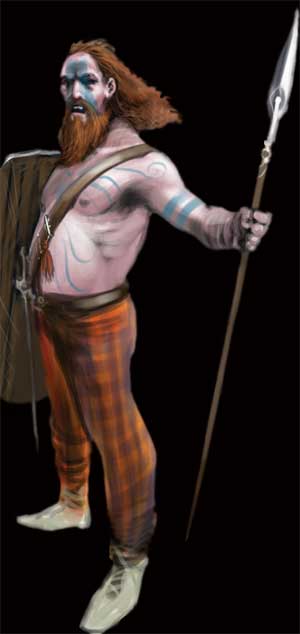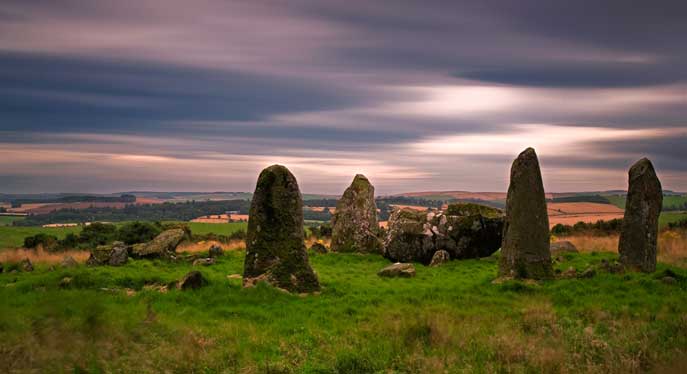|
||||||||
 |
Transcribed from oral traditions in the 10th century, the earliest of the Pictish Chronicles (there are seven) begins with Cruithne and his seven sons, all of whom, along with Cruithne himself, are most likely mythical. They are probably the names of the seven provinces into which Alba, the land of the Picts, was divided at a very early stage in the nation’s history. They may also be the ancient clan names of the tribes who inhabited those areas. Cruithne, son of Cinge, according to an old legend recorded in the Irish ‘Book of Lecain’, was the first king of the Picts, and is supposed to have ruled for 100 years. His mysterious ‘father’, Cinge, may simply be a form of the obsolete Gaelic (or Pictish?) word ‘cing’, meaning strong or brave. It may also be a form of the word ‘cinneadh’ meaning clan, tribe, kindred or offspring. Cinge’s own pedigree is given as ‘son of Luchtai, son of Partolan, son of Agnoin, son of Buain, son of Mais, son of Fathecht, son of Japheth, the son of Noah’. These middle-eastern origins given to Cinge, and by their logical extension to the Picts, may not be mere fancy as we shall see later on. The name Cruithne itself may have come from the early Irish word ‘Cruth’, meaning ‘shape’ or ‘design’. This could possibly refer to the Picts’ supposed habit of tattooing themselves (Picti-painted), or from their unique stone carvings that are likely to have been painted and highly coloured. It may also mean ‘the people of the wheat’. Cruithne is described in the legends as having seven sons whose names were Cait, Ce, Cirig, Fib, Fidach, Fotla and Fortrenn. These sons (probably clans) had Pictland divided up between them, and had territories named after them. Some of these can still be identified in our modern place names. |
Ce was given Mar and Buchan. Possibly seen in the name Bennachie. Cirig was given Angus and the Mearns, formerly known as Magh Circinn, i.e. the Plain of Circinn. Fib was given Fife, a very old name; its original meaning lost in obscurity. Fidach was given Moray and Ross. Fidach may mean ‘the wood dwellers’. Fotla was given Atholl and Gowrie. Atfodla was the old form of Atholl, which means ‘the ford of Fotla’. She was a Celtic goddess, and Ireland was sometimes called after her in poetic fashion. The name Atholl is often claimed to be derived from ‘Ath Fhodhla’, said to mean ‘New Ireland’. This is quite incorrect however, as the Gaelic word ‘Ath’ means ‘next’ and not ‘new’, or, as we have already seen, it can mean a ford in a river. Fortrenn was given Strathearn and Menteith. Anciently, Strathearn (southern Perthshire) was known as Fortrenn, which is believed to mean ‘the people of the slow winding river’. Strathearn may mean the valley of the Irish (Eireann), but could be from ‘AR’, a pre-Celtic word meaning flowing water.
Our list of Pictish Kings begins properly with King Gede. As with Cruithne and his seven sons, it is the view of many historians that the names of all the earliest kings, from Gede (No. 1) right up to, though not including, Brude son of Mailcon (No.38), are also mythical. That is not a view that is automatically shared by this author, who sees no reason to reject the validity of the King Lists, and is prepared to accept their provenance. Regarding the lengths of the earliest reigns (150, 100, 15, 40, 7, 50 years etc.), they are probably of some mystical religious significance that has been lost to us. The scribes who recorded the King Lists were not silly people. They knew that no one could reign, as King Gede is supposed to have done, for 150 years, nor King Tharain for 100. We must simply show what was recorded at the time and accept that they had their own reasons for giving them such extraordinarily long reigns. The spellings of the names look strange. This is because the Lists were written using both Latin and Gaelic and were an attempt to reproduce Pictish pronunciation in Latin or Gaelic forms. We cannot even be sure which language (or languages) the Picts spoke. The Ogam script that they used on their stone carvings is, in many instances, badly worn, and often indecipherable, whilst the meaning and translation of those inscriptions that have managed to survive the worst that Scottish winters have been able to throw at them is the subject of heated debate among scholars. The reader’s confusion may be further compounded when it is realised that the Picts pronounced the letter W (sometimes shown as UU i.e. double-U) with an F sound from around the 7th century onwards. That is, Uurad or Wrad became Ferad, and Uurguist became Forgus or Fergus. This peculiarity of speech, which is a joy to listen to, can still be heard to this day in the North-East of Scotland where the word ‘what’ is pronounced ‘fit’, and the word ‘where’ is pronounced ‘faur’. |
 |
REX PICTORUM |
Back to Top
Return to Paisley T. A. website
© Ron Henderson 2008-09
